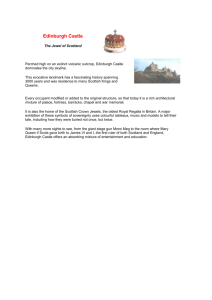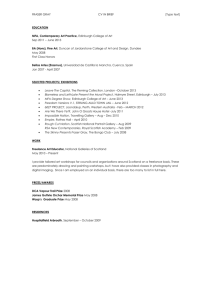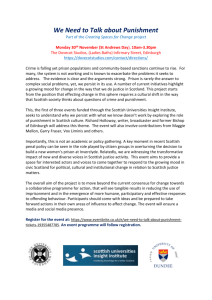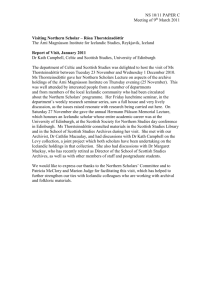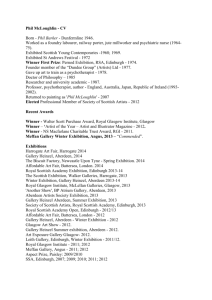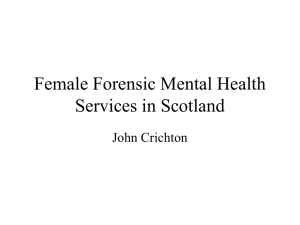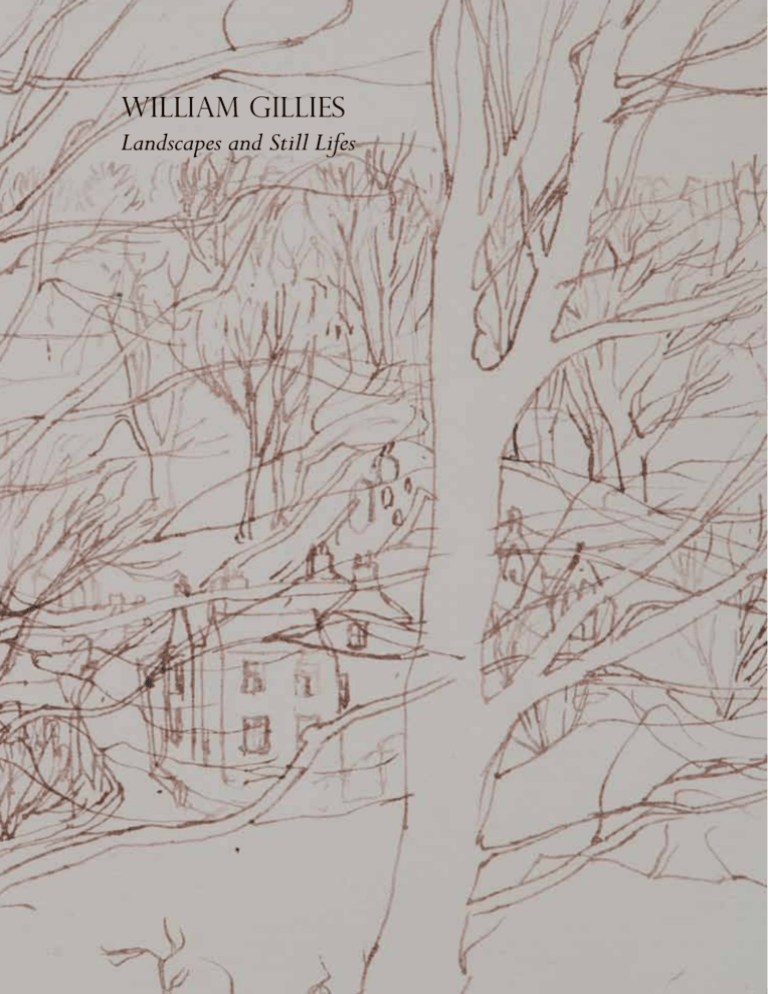
William gillies
Landscapes and Still Lifes
Above: William Gillies on the Lammermuirs, c.1920s
Cover: Trees near Temple
William gillies
Landscapes and Still Lifes
11 January - 3 march 2012
16 Dundas Street, Edinburgh EH3 6HZ
Tel 0131 558 1200 Email mail@scottish-gallery.co.uk
Web www.scottish-gallery.co.uk
foreword
Tommy Zyw
William Gillies was an influential teacher to several
generations of painters and is widely regarded as one of
Scottish art’s most beloved sons.
He was perhaps The Scottish Gallery’s most important artist holding seven exhibitions
with the Gallery during his lifetime and we still exhibit his paintings on a regular basis.
Gillies’s first ever show was in the front window of a Haddington watchmaker’s in 1920.
Unbeknown to the locals at the time, it was the start of an artistic career for one of the
most significant British artists of the 20th century.
William George Gillies was born in Haddington in 1898. He entered Edinburgh
College of Art in 1916, but his studies were interrupted when he was called for service
with the Scottish Rifles in 1917. He saw action in France and was wounded and gassed,
spending three weeks in hospital in Glasgow. He returned to his studies in 1919, putting
the horrors of war behind him and at the end of his diploma was awarded a travel bursary.
In 1923 he went to Paris and worked as a student underneath the French Cubist painter,
André Lhôte, an experience that had no long-term effect on the young artist. Although
Lhôte’s teaching was not to Gillies’s taste it did give him the chance to witness avantgarde painting first hand; a far cry from his classical training at Edinburgh College of Art.
Shortly afterwards he was accepted to the staff of ECA, a post which was to tie him to the
College for the next 40 years.
After a spell of living in Edinburgh on Willowbrae Road in 1939 Gillies moved with his
mother and sister to a cottage in Temple - a small town on the bank of the river Esk. The
Gillieses were not city folk, and a return to the country was like going home. The garden
and surrounding countryside provided plentiful subject matter with occasional trips to
Perthshire, the West Coast and Fife. When Robin Philipson returned from a painting trip
to New Mexico he told Gillies that he would definitely enjoy it. Gillies replied that he
‘hadn’t done the Glasgow area yet.’
Gillies’s mastery of the Scottish landscape came from a deep knowledge and
understanding of the land. His compositions and colour harmonies seem to extract the
very essence of each landscape he experienced.Where the ordinary eye would see nothing
of interest - fields in the middle distance, a stretch of moorland, an expanse of sky - Gillies
sees positive elements, crucial to his pictorial arrangement. His domestic environment
too provided much inspiration; his eye constantly searching and experimenting with the
subtle tabletop arrangements of ordinary objects for his still lifes: his sisters’ ceramics, a
“tilly lamp”, a pot of flowers from the garden.
He was a painter who was not concerned with social or political comment, or indeed
art historical debates. In 1931 the Society of Scottish Artists secured a loan exhibition
of 12 pictures by Norwegian master Edvard Munch (1863-1944). Gillies was deeply
impressed by the brooding quality of Munch’s work, although his nihilistic message was
less attractive: ‘If I want to send a message, I’ll write a letter,’ he remarked.
Gillies regarded ‘his’ college and his students as his home and family, and lived to see
four generations of students achieve national and international success. It can’t have been
2
easy to be Principal during the 1960s, a time of social turbulence accompanied by the
odd student sit-in; but Gillies’s fair and steady approach steered the College safely. He
retired in 1966 to focus on painting full time. He believed that painting was something
to be enjoyed both by the painter and viewer alike, an attitude he shared with Redpath,
MacTaggart and Maxwell, painters at the core of the group now known as the ‘Edinburgh
School’ and carried on by the next generation: Blackadder, Houston and Michie. The
tributes from fellow painters to the rear of this catalogue give personal insight into a man
who while devoting himself to his college and his art was at the same time a very private
individual.
Gillies took influences from a variety of sources throughout his career but he was at his
core primarily a Scottish painter. He worked quietly from his Temple cottage, the routine
of studio life essential for his creative output: what William McTaggart described as ‘the
good habit’. His paintings are not pretentious or didactic; he never painted to please or
let his success affect his artistic vision - the idea that a modern artist can have something
important to say to the world about the view out his own kitchen window. Looking at his
work we see his beloved Lothian and Border landscape through his eyes; a distillation of
love and knowledge that has changed the way we look at the landscape.
Gillies in his studio, c.1960
3
Anstruther Harbour
Ink drawing, 26 x 32.5 cm
Signed lower right
4
Temple Gloaming, 1940
Oil on panel, 39 x 53.5 cm
Exhibited: William Gillies Retrospective,
Scottish Arts Council, 1970 (no. 35)
Temple, Gillies’s home from 1939 until his death,
provided endless subject matter: the curving main street,
the back gardens and often buildings glimpsed through
trees. Gillies paints in a narrow colour range but deploys
infinitely subtle tones; if an oil painting has become only
slightly discoloured with time it can become illegible so
that a light surface clean can reveal the brilliant, original
tonal composition which here describes perfectly the dark
surface and stone cottages of Temple’s main street as the
light fades.
5
Comrie, 1920
Oil on board, 40 x 50 cm
Signed lower right and inscribed on
verso: “Months camp with Alan Ronald
and George Watson and two medical
students”
Exhibited: Christmas Exhibition, 1971,
Compass Gallery, Glasgow
William Gillies Retrospective, Scottish Arts
Council, 1970 (no. 4)
6
Landscape painting was not on the curriculum at Edinburgh
College of Art when Gillies was a student but this hardly
interfered with his development of a lifelong passion. This
oil from 1920 was painted on a trip during the summer
holidays and is inscribed on the verso: “Month’s camp
with Alan Ronald and George Watson and two medical
students”. The colours are limited, the drawing with the
brush decisive, the ‘information’ he chooses to include
typically informative but personal.
The Old Lime Kilns
Watercolour & ink, 33 x 58 cm
Signed lower right
Provenance: Collection of Jack Norman,
architect
7
Border Hills
Oil on canvas board, 42 x 51 cm
Signed lower left
8
Between TempleWood and Carrington, c.1960
Watercolour, brush and black ink, 33.7 x 50.8 cm
Signed lower left
Provenance: The collection of Dr. Robert A. Lillie
With its grand trees and the fine spire on the church,
Carrington, which lies tucked away a few miles south of
Dalkeith, was one of Gillies’s favourite subjects during
the 1940s when he exhibited eight watercolours with the
village in the title.
9
TummellValley, 1934
Watercolour & pencil, 22 x 35.5 cm
Signed and inscribed “Tummel Valley, Aug, 1934” lower left
10
Summer Landscape, Esperton near Temple, 1952
Watercolour, 25.5 x 33.5 cm
Signed lower left
Exhibited: William Gillies and the Edinburgh School,
The Scottish Gallery, 2006 (no.6)
11
TempleWood
Ink and watercolour, 57.5 x 77.5 cm
Signed lower right
12
Stooks
Oil on panel, 44 x 79 cm
13
Gillies was a prolific watercolourist and his approach varied throughout his life. In the
earlier period he only employs the brush, sometimes wet on wet, with a minimum of
drawing which can lend a spontaneous and gestural quality and often captures a particular
moment or some fleeting atmospheric effect. From the 1940s he tended to draw first,
with pencil or pen and then use monochrome or colour washes but he would often
return to ‘pure watercolour’ when the subject demanded, as in Rosebery, near Temple. Half
a mile or so south along the course of the South Esk is Rosebery reservoir and Gillies
will have parked his faithful Ford Granada (he had a lifelong love affair with the internal
combustion engine) on the B6372 and climbed up a little to look down on the grey water
and rain sodden trees on the far bank.
Gillies had seven one-person shows with The Scottish Gallery in his lifetime but in
addition there was often a ‘bin’ of unframed Gillies watercolours displayed in the premises
on Castle Street which were constantly on sale at the ‘bargain’ price of 20 guineas.
14
Rosebery, near Temple, c.1960
Watercolour, 47 x 62 cm
Signed lower left
15
The Loch, 1946 (possibly in the
Pentlands)
Pen and ink wash, 49 x 69 cm
Signed lower right
Provenance: With Aitken Dott & Son,
Edinburgh
Private Collection, Edinburgh
With Cyril Gerber, Glasgow
Private Collection, Glasgow
Exhibited: William Gillies, Festival
Exhibition, Aitken Dott & Son, 1963
(no. 35)
Gallery Exhibition, Cyril Gerber Fine Art,
Glasgow, October 1996
16
Lowland Landscape,Winter, c.1950
Ink and watercolour, 56.5 x 78.5
Signed lower right, inscribed on mount
Provenance: Collection of Dr. Robert A. Lillie
Private collection, Scotland
Dr. Robert A. Lillie bought his first picture by Gillies
in 1940. When he died in 1977 he had amassed a vast
collection of Scottish paintings, all jam-packed into his
bungalow on the outskirts of Edinburgh. Dr. Lillie owned
372 pictures by Gillies, of which a few feature in this
exhibition; an extraordinary loyalty to the work of one
artist.
17
Winter Trees
Pencil & watercolour, 23.5 x 30 cm
18
Autumn Trees,Tummel
Watercolour, 52 x 63.5 cm
Signed lower left
Exhibited: William Gillies, Festival Exhibition,
Aitken Dott & Son, 1963 (no. 35)
19
Arniston Garden from the Mushroom Field, 1944
Sepia ink and wash, 28 x 38.5 cm
Signed lower right
20
Garden at Auchindoir, c.1936
Watercolour, 56 x 77 cm
Signed lower left
In July 1939 Gillies travelled to Spinningdale on the
Dornoch Firth, then to Auchindoir in Aberdeenshire.
This was the last of Gillies’s extended summer trips for
several years for a number of reasons. The outbreak of the
War restricted his ability to travel and his family’s move
back to Temple also meant that Gillies did not need to
travel far to find his favourite subject matter.
21
Spring Landscape
Watercolour, 25 x 35 cm
Signed lower left
Exhibited: Scottish Gallery Christmas
Exhibition, 1968 (no. 41a)
22
Mountain near Balmacara
Watercolour, 18 x 25 cm
Signed lower right
23
On the Meldons Road, 1953
Watercolour, 51.5 x 65 cm
Signed and dated lower left
Provenance: Private Collection, Australia
Exhibited: Festival Exhibition,
Aitken Dott & Sons, 1954 (no.54)
24
We are in the heart of ‘Gillies country’. He will have
stopped on the minor road between Eddleston and the
A72 west of Peebles which runs between White and
Black Meldon. His subject is the hillside, its fields and
copses climbing to a high horizon and a typically dark sky.
The watercolour is anchored by the beautifully drawn
stone dyke at the bottom, marching alongside the road and
leading the eye into the landscape.
Autumn Moon, c.1955
Oil on canvas, 45 x 85 cm
Signed lower right
Provenance: Collection of Fred Peyser Jr.
25
Above: Still Life with Gold Urn and BlueVase
Oil on canvas, 76 x 91.5 cm
Signed lower right, inscribed on verso:
“Study in Gold and Blue” W. Gillies £60
Right: Cottage Window, c.1946
Lithograph, 100 x 70 cm
Provenance: Collection of Mr. McInnes, Edinburgh
Published by the Arts Council
26
27
Still Life withYellow Cloth & BlueVase, c.1954/5
Oil on canvas, 35 x 66.5 cm
Signed lower right
Provenance: Private Collection, purchased from
The Scottish Gallery in 1970
Exhibited: Exhibition of Paintings -WG Gillies,
The Scottish Gallery, February 1970 (no. 35)
28
29
Cavehill Near Lyne, 1956
Pencil, 25.5 x 35.5 cm
Signed and dated lower left
30
Clovenfords, 1960
Watercolour, 22 x 35.5 cm
Signed and dated lower right
The landscape between Edinburgh and the Borders
changes at every turn. Roads follow river valleys, passing
through towns and villages, and wind steeply up on to
high moorland, battered by wind, rain and snow. Gillies
went by car or motorbike from his cottage in Temple
and explored again and again the landscape of the area,
stopping at the side of the road wherever and whenever
something caught his eye. One of his favourite views is one
taken from the side of the road, looking across to the valley
on the opposite side.
31
Camping in the Highlands, c.1933
32
During his holidays from the College Gillies travelled
extensively around Scotland. These trips, accompanied
by friends and family were a chance to unwind from the
pressures of teaching and an opportunity to focus wholly
on his drawing and painting. This photograph, taken on
one such trip in 1933 was probably taken by John Maxwell
or his sister Emma.
Crofts Argyll, 1949
Watercolour, 24.7 x 31 cm
Signed and dated
Provenance: Estate of the late Katie Horsman
With Ewan Mundy Fine Art, Glasgow
Collection of Giseli Gresswell, Oxford
Private collection, UK
33
West Highland Gate
Pencil, 11 x 20 cm
Signed lower left
Provenance: Collection of Hilary and Keith McCallum
34
Crofts in a Landscape
Watercolour, 52.5 x 70 cm
Signed lower right
35
Still Life, Blue and Red, 1957
Oil on canvas, 91.5 x 99 cm
Signed lower right
Provenance: Collection of Dr. Henry Walton
Exhibited: The John Moores Exhibition, Liverpool, cat no. 142
Six Scottish Painters, Nottingham University, 1959 (no. 15)
14 Scottish Painters Exhibition, Commonwealth Institute, London,
1963/4 (no. 35)
William Gillies Retrospective, Scottish Art Council, 1970 (no. 73)
William Gillies Centenary Exhibition, Royal Scottish Academy,
1 August – 11 October 1998 (no. 25)
36
This magnificent still life is painted with a rich impasto,
giving the surface of the painting a strong textural
quality. The tabletop, surrounded by shifting squares
and rectangles frames the still life arrangement in an
ambiguous space. Some of the still life objects are cleverly
‘transforming’ into abstract shapes. The intellectual play
between squared and curved forms is a familiar element
in Gillies’s later still lifes which owe something in their
considered, sonorous quality of George Braque (18821963). The French master exhibited at the RSA Edinburgh
Festival exhibition of 1956.
37
Winter Afternoon, 1952
Watercolour, 25 x 34.5 cm
Signed and dated lower right
38
Trees near Temple
Sepia ink, 28 x 38 cm
Signed lower left
Provenance: Collection of Hilary and Keith McCallum
39
Border Landscape
Watercolour and pencil, 24 x 31 cm
Signed lower right
40
Sunset, c.1960
Watercolour and body colour, 31 x 50.8 cm
Signed lower right
Provenance: The collection of Dr. Robert A. Lillie
Private collection, Scotland
Exhibited: William GilliesWatercolours, The Scottish Gallery, 1968 (no. 31)
41
Envoi
The comments below were written by friends and
colleagues to accompany W. Gordon Smith’s book A Very
Still Life, Atelier Books, Edinburgh, 1991
Sir Robin Philipson RSW RGI RSA RA PRSA (1916-1992)
He had in abundance whatever it is that inspires people to make the most of life. A quiet
man, totally incapable of self-promotion. And there was never any chance that he would
smother himself in dead language, leaving only a cipher or sign.
I know he was enormously proud of his decorations. He adored it when he became
CBE. After one of our many chats round the fire at Temple – we had eaten the bacon, egg
and sausages at midnight to keep us going till 3a.m. – I got up to go. He said, “Got another
letter from the Palace.” “Not it?” I said. “’Fraid so,” he said. We had to get him a tail-coat.
David McClure RSW RSA (1926 – 1998)
I have been trying to pin down my thoughts on the great man. I do not find it easy. In
a way he remains an enigma. I was a student for five years while Gillies was Head of
Paintings and yet I had only three or four lessons from him in all that time. The first
was when MacTaggart called for Bill Gillies to come and see a painting I had done. He
admired it generously and commended it for its tonal values. I had on the easel a much
more freely painted thing with apples and a jug. He looked at it and said “Apples are not
tennis balls. They have planes.” He then proceeded to push the wet paint around with his
horny thumb, making the apples truly three-dimensional, and expressed in ‘planes’. On
another occasion I was propounding a theory I had come across about ‘Organic Colour
Values’… I asked him if he did not agree with this. His response was typically antiintellectual. “No. Nature always gets the colour wrong, so you have to try to improve it.”
Frances Walker RSA RSW (b.1930)
I first saw him when I went to do a drawing test. He appeared to be a janitor bustling around
arranging antique busts for groups of anxious hopefuls to draw – then collecting our
efforts. He wore a well-used smock overall belted around the middle. An unpretentious,
practical, busy person – approachable but not likely to suffer fools or arrogant people
gladly. He had a sharp, shrewd way of looking at people. I liked his direct, very Scottish,
Lowland personality, his pawky dry humour and economy of words…
I know he had a strong influence on me – by example, in his dedication as an artist and
by his work. The linear, lyrical quality of his work and descriptive use of colour – and
forget when he it was who proposed me as an Associate of the RSA. His whole vision
appealed to me. I felt instinctively that what I wanted to say in my work was more related
to Gillies than the ‘painterly’ or gestural Scottish painting of the time. I envied his speed,
facility and skill, and admired the fluency of his pen-and-ink drawings and watercolours.
His work reveals his continuous celebration and enjoyment of snow, rainbows, stormy
skies, twilight, moonlight, sunlight…
42
William Gillies teaching the life class at Edinburgh College of Art
43
David Michie OBE, RSA (b.1928)
His paintings reflected him – very unfussy, economical, unpretentious, without any
pomposity and never heavily solemn. He didn’t like pretentiousness in others. It was clear
to all his students that he had integrity, cared about their wellbeing and the wellbeing of
the school. He set high standards for himself and expected similar from those around
him. He could be generous in praise and critical of slack work or behaviour by students
and colleagues – quite fiercely.
His indulgences were simple – cars, motor bikes, chocolate biscuits and cigarettes
whose smoke stained a wisp of a moustache. He sold me the first car I possessed – a
Triumph Gloria with real leather upholstery – for £30. He was an enthusiastic maker of
homemade wine (like his mother), responding to the flowers and fruits of the season –
dandelion in early summer, gooseberry following. Raspberry was a favourite.
Gillies, Maxwell and Willie Wilson are an interesting trio to compare. All bachelors
with idiosyncratic ways of relating to women. Gillies was very close to his mother and
sisters. Apart from them women seemed to exert no fascination. In fact, Gillies seemed
to be happily asexual. He had a great sense of fun and loved the fancy dress carnival of the
college Revels. I remember him dressing up as Harpo Marx and on another occasion as a
racing cyclist – padded body and arms giving him comic bulging muscles.
While he was a naturally modest person, he had a proper sense of worthy qualities. He
said of himself that he might be remembered as a ‘little master’. However one describes
him (I very much dislike ‘ranking’ artists) it is undoubtedly true that all who knew him
and his work were enriched.
William Jackson (Director of The Scottish Gallery 1975-1991)
He was not a great innovator and certainly did not break new ground, but he might well
prove to be one of the greatest natural painters this country has produced this century.
I first visited Temple in the autumn of 1968. Here was this busy and amiable man who
trotted everywhere with little, hurried steps. I remember the sitting-room at the back of
the house, with its variety of wallpaper, and large key paintings which were astonishing
to me in their brilliance… The day was concluded with tea, toast and home-made apple
jelly. There was also a bottle of elderberry wine, which is why I remember little of the
return journey.
Dame Elizabeth Blackadder RSA RA RSW RGI (b.1931)
He was special to me. When I was a young student in 1949, and being a woman, I got
no feeling from Gillies that I was in any way different – you were a painter, and it didn’t
matter you were, man, woman, whatever. He just expected you to get on with it. That
sense of there being no difference may not seem very much, but I think it was something
very special to him and important to me as a painter, right from the beginning. I was very
lucky to have such encouragement.
44
Top: The artist at work, c.1933
Bottom: William Gillies in the garden at Temple
45
Chronology
SirWilliam Gillies,
CBE, RA, RSA, PPRSW, D.Litt, FEIS
1898
Born 21 September, Haddington, East Lothian, son of John (born 1856) and
Emma Gillies (nee Smith, born 1864) and brother of Janet (born 1896) and
Emma (born 1900).
1909-1916 Educated at Knox Academy, Haddington (awarded Dux Medal in 1916).
Enrolled at Edinburgh College of Art, studied for two terms.
1916
1917
Called for National Service. Drafted with the Scottish Rifles to France
where he saw service around Arras. Wounded and gassed and returned to
Scotland in 1918.
Resumed studies at Edinburgh College of Art.
1919
First solo exhibition in Haddington watchmakers, owned by local art
1920
enthusiast Alexander Wright.
Death of Gillies’s father.
1921
Awarded Diploma in Drawing and Painting and post-Diploma Scholarship
1922
providing studio facilities for a further year’s study.
Became a founder member of the exhibiting society the 1922 Group. The
group’s exhibitions were held in Edinburgh from 1923-29.
Awarded Travelling Scholarship and, with fellow recipient William Geissler,
1923
went to Paris to study under André Lhôte, and travelled to Italy.
Returned to Scotland.
1924
Appointed Assistant Art Master at the Royal Academy, Inverness.
Appointed part-time lecturer in School of Drawing and Painting, Edinburgh
1925
College of Art.
Gillies’s family moved from Haddington to 162 Willowbrae Road,
1928
Edinburgh.
Joint exhibition with Frances Hodgkins, St George’s Gallery, London.
Work first exhibited at the Royal Scottish Academy.
Moved with sisters and mother to house on Willowbrae Road, Edinburgh.
1929
John Maxwell joined the staff of Edinburgh College of Art, and became a
lifelong friend.
Scottish Society of Artists Annual Exhibition included 12 works by Edvard
1931
Munch (1863-1944).
Shared a studio with William MacTaggart at 45 Frederick Street.
Invited to become member of the exhibiting society, the Society of Eight.
1932
The Society’s exhibitions were held in Edinburgh from 1912-1938.
Appointed full-time lecturer, Edinburgh College of Art.
1934
Work first exhibited at the Society of Scottish Artists.
Death of Gillies’s sister, Emma.
1936
Elected professional member of the Society of Scottish Artists.
1937
Gillies moves to cottage in Temple, Midlothian, with mother and sister Janet.
1939
Elected Associate of the Royal Scottish Academy.
1940
Work included in the exhibition Six Scottish Painters, Reid and Lefevre,
1942
London.
Appointed Head of the School of Drawing and Painting, Edinburgh College
1946
of Art.
Elected Royal Scottish Academician.
1947
Solo exhibition at the French Institute, Edinburgh (drawn from collection of
1948
Dr. R. A. Lillie) Became member of the Educational Institute of Scotland.
Solo exhibition at The Scottish Gallery (The first of seven during Gillies’s
1949
lifetime).
46
1950
1951
1953
1954
1957
1959
1960
1962
1963
1964
1966
1969
1970
1971
1973
Elected member of the Royal Scottish Society of Painters in Watercolour.
Work included in the exhibition 60 Paintings for ’51, Festival of Britain,
South Bank, London.
Solo exhibition, The Scottish Scene, The National Trust for Scotland,
Edinburgh, (drawn from collection of Dr. R. A. Lillie).
Arts Council exhibition, Paintings, watercolours and drawings by WG Gillies and
John Maxwell, New Burlington Galleries, London.
Awarded CBE.
Appointed Principal of Edinburgh College of Art.
Death of Gillies’s sister Janet, Temple.
Work included in the exhibition Modern Scottish Paintings from the
Collection of Dr. Lillie, Scottish National Gallery of Modern Art, Edinburgh.
Elected President of Royal Scottish Society of Painters in Watercolour.
Death of Gillies’s mother.
Elected Associate of the Royal Academy.
Retired as Principal of Edinburgh College of Art. Received Honorary
Degree of Doctor of Letters from Edinburgh University. Elected Fellow of
the Educational Institute of Scotland.
Retired as President of Royal Scottish Society of Painters in Watercolour.
Knighted in recognition of his services to art in Scotland.
Retrospective exhibition, WG Gillies, Royal Scottish Academy and Scottish
Arts Council Gallery, Edinburgh.
Elected Royal Academician.
Died 15 April, Temple.
Selected Bibliography
Books, Articles and Exhibition Catalogues
T Elder Dickson, WG Gillies, Retrospective Exhibition, Scottish Art Council, Edinburgh,
1970
Jack Firth, The Edinburgh School, The Scottish Gallery, Edinburgh, 1993
Douglas Hall, William Gillies & The Scottish Landscape, Scottish Art Council, Edinburgh,
1980
Philip Long, William Gillies, Watercolours of Scotland, National Galleries of Scotland,
Edinburgh, 1994
Philip G Napier, William Gillies – Our Neighbour, Temple, 1980
The Scottish Gallery, Gillies, Paintings, watercolours and drawings, The Scottish Gallery,
Edinburgh, 2003
W Gordon Smith, WG Gillies, AVery Still Life, Atelier Books, Edinburgh, 1991
Joanna Sodden and Victoria Keller, William Gillies, Canongate, Edinburgh, 1998
Other Sources
Royal Scottish Academy Archives: Gillies Bequest which includes manuscript notes,
postcards, letters, exhibition catalogues, newspaper cuttings, photographs and personal
memorabilia.
Still Life with Honesty (1970), Film of Scotland Collection, Scottish Screen Archive
47
Published by The Scottish Gallery to coincide with the exhibition
William Gillies, Landscapes and Still Lifes
11 January - 3 March 2012
Exhibition can be viewed online at www.scottish-gallery.co.uk/williamgillies
ISBN 978-1-905146-62-8
All rights reserved. No part of this catalogue may be reproduced in any form by print,
photocopy or by any other means, without the permission of the copyright holders and
of the publishers.
Acknowledgments
The Scottish Gallery would like to thank Dr. Joanna Soden and the
Royal Scottish Academy for help in compiling this exhibition.
We would also like to acknowledge Duncan R Miller Fine Arts, London
and Ewan Mundy Fine Art, Glasgow.
Designed by www.kennethgray.co.uk
Photography by William Van Esland Photography, www.wvephotography.com
Printed by Stewarts
Credits
Black and white photographs: Royal Scottish Academy Archives (Gillies Bequest)
Gillies in his Studio: Scotsman Publications Ltd. Licensor www.scran.ac.uk
16 Dundas Street, Edinburgh EH3 6HZ
Tel 0131 558 1200 Email mail@scottish-gallery.co.uk
Web www.scottish-gallery.co.uk
Right: William Gillies at Loch Tummel, 1936
48
49
50

